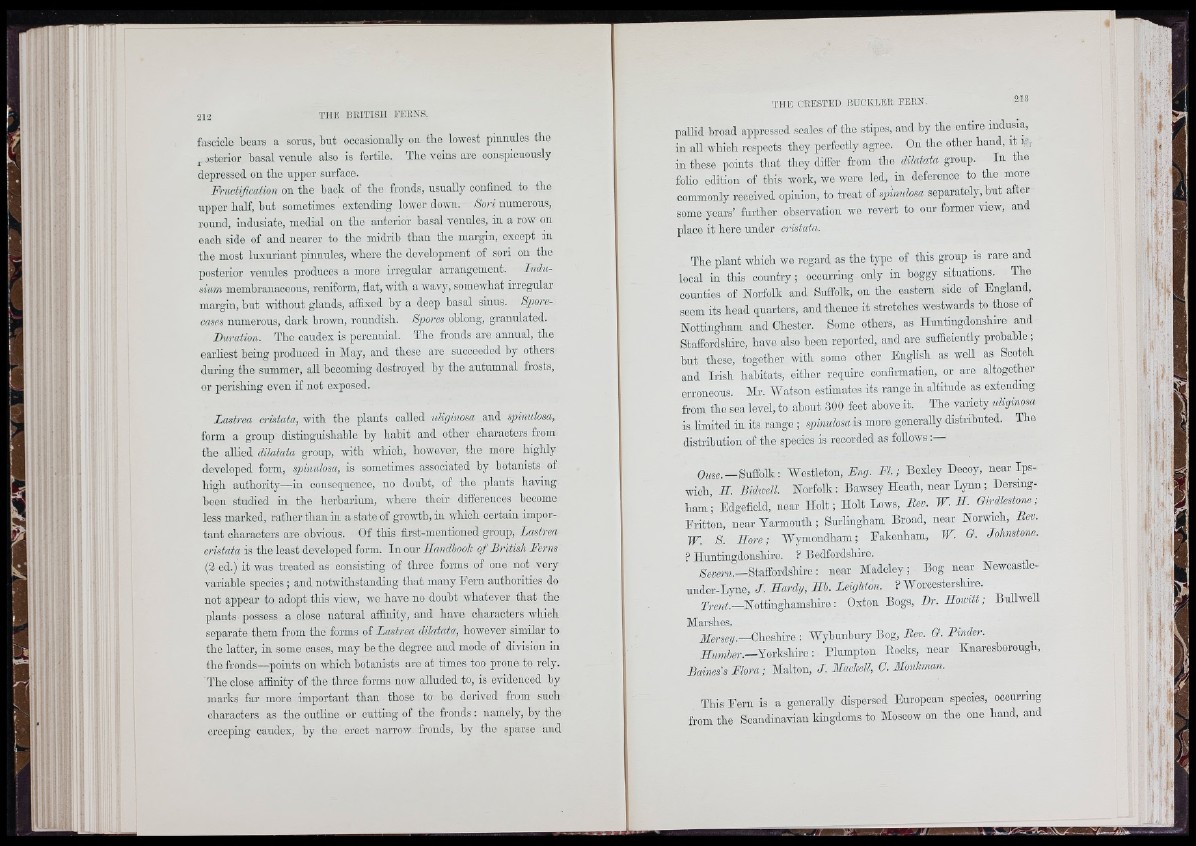
filsoiolo bears a sorus, but occasionally on the lowest pinnules the
^ jstcrior basal venule also is fertile. Tho veins are conspicuously
doprossed on tho upper surface.
Fructifleation on tho hack of the fronds, usually confined to the
upper half, but somotimos extending lower down. Sori numerous,
round, indusiate, medial on tho anterior basal vonules, in a row on
each side of and nearer to the midrib than tho margin, except in
tho most luxuriant pinnules, where tho development of sori on tho
posterior vonules produces a more irregular arrangement. Indusium
mombranacoous, roniform, fiat, with a wavy, somewhat irregular
margin, hut without glands, affixed hy a deep basal sinus. Sqmre-
cases numerous, dark brown, roundish. Spores oblong, granulated.
Duration. Tho caudex is poronnial. Tho fronds aro annual, the
earliest being produced in May, and these aro succeodod hy others
during the summer, all heooming destroyed by the autumnal frosts,
or perishing even if not exposed.
Lastrea cristata, with the plants called ulujinosa and spinulosa,
form a group distinguishable hy hahit and other characters from
the allied dilatata group, with which, however, the moro highly
developed form, spiinulosa, is sometimes associated hy botanists of
high authority—in consoquenoo, no doubt, of tho plants having
been studied in the horharium, where their difforenoos become
less marked, rather thau in a state of growth, in which certain important
characters are obvious. Of this first-mentionod group, Lastrea
cristata is the least dovclopod form. In our Handbook of British Ferns
(2 ed.) it was treated as consisting of three forms of ono not very
variable species ; and notwithstanding th a t many Fern authorities do
not appear to adopt this view, wo havo no doubt whatovor that the
plants possess a close natural afdnity, and have characters which
separate thorn from the forms of Lastrea dilutaia, however similar to
tho latter, in some cases, may he the degree and mode of division iu
the fronds—points on which botanists are at times too prone to rely.
The close affinity of the three forms now alluded to, is evidenced hy
marks far moro important than thoso to he derived from such
characters as the outline or cutting of tho fronds: namely, by the
creeping caudox, hy the erect narrow fronds, hy the sparse and
pallid broad appressed scales of the stipes, and by the entire indusia,
in all which respects they perfectly agree. On tho other hand, it ir
in these points that they diifor from tho dilatata group. In tho
folio edition of this work, wo wore led, in deference to the more
commonly received opinion, to treat of spinulosa separately, but after
some years’ further observation we revert to our former view, and
place it here under cristata.
The plant which wo regard as tho typo of this group is rare and
local in this country ; oocurring only in boggy situations. The
counties of Norfolk and Suffolk, on the eastern side of England,
seem its head quarters, and thence it stretches westwards to those of
Nottingham and Chester. Some others, as Huntingdonshire and
Staffordshire, have also boon reported, and aro sufficiently probable ;
hut those, together with some other English as well as Scotch
and Irish habitats, cither require confirmation, or aro altogether
erroneous. Mr. Watson estimates its range in altitude as extending
from tho sea level, to about 300 feet above it. The variety uliginosa
is limited in its range ; spinulosa is moro generally distnhutod. The
distribution of tho spooios is recorded as follows
0„se. — Suffolk: Westleton, Eng. F I ; Bexley Decoy, near Ipswich,
II . Lidwell. Norfolk: B a w s o y Heath, near L y n n ; Dorsingh
am ; Edgefield, near H o lt; Holt Lows, Bev. W. H. Girdlestone;
Fritton, near Yarmouth; Surlingham Broad, noar Norwich, Bev.
JF. S. Ilore; Wymondham; Fakeiiham, JF. G. Johnstone.
? Hnntingdonshiro. ? Bedfordshire.
Sfi®«-«.—Staffordshire: near Madeley ; Bog near Newoastle-
vcaiex-Ejno, J Hardg, Hb. Leighton. ? Worcestershire.
Nottinghamshire: Oxton Bogs, L r . Iloioitt; Bullwell
Marshes.
J/crsey.—Cheshire : IVyhunhury Bog, Rev. G. Finder.
E um b e r .-Y oA sU v o : Plumpton Rocks, near Knaroshorongh,
Baines’s Flora; Malton, J . Mackell, C. Monkman.
This Fern is a generally dispersed European species, occurring
from the Scandinavian kingdoms to Moscow on the one hand, and
■1 r' • ■
r ' ! •'
I
. .’T!
>!•
* ,c
--